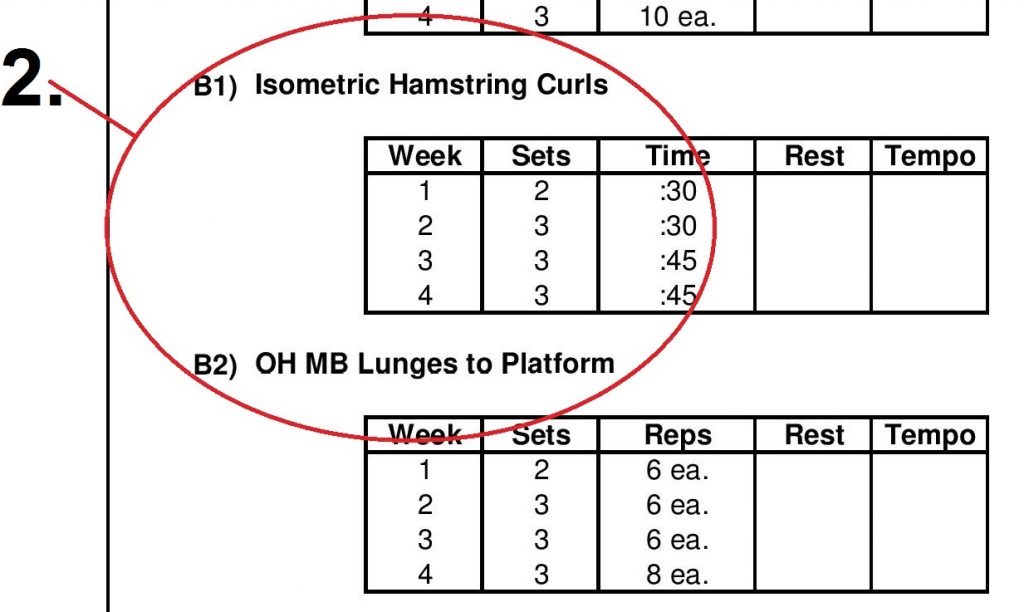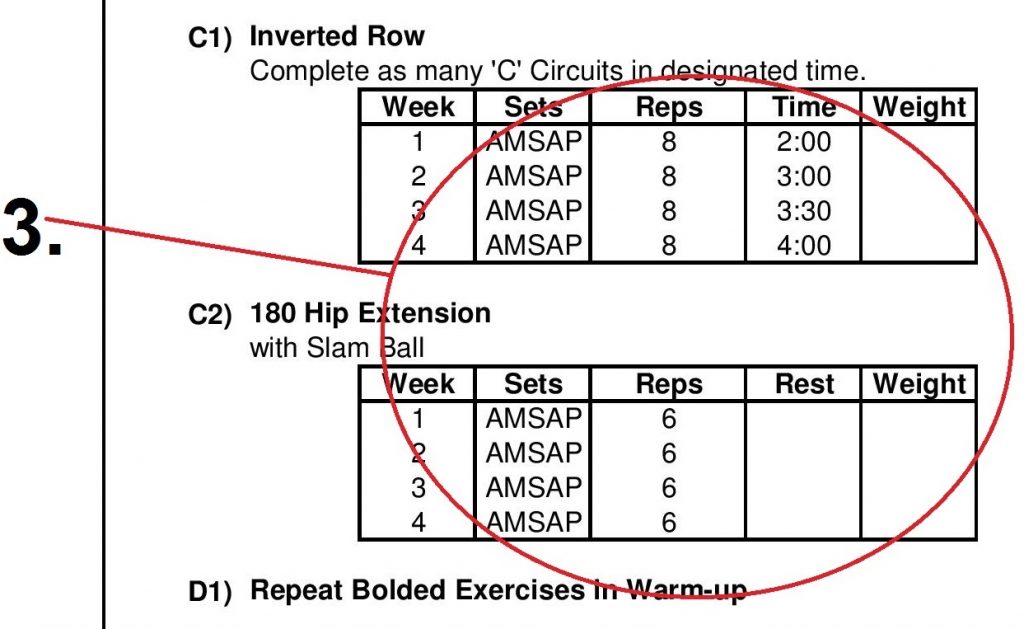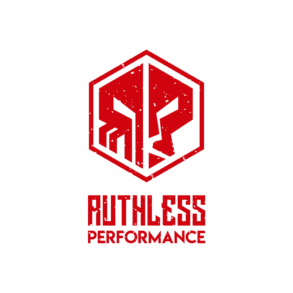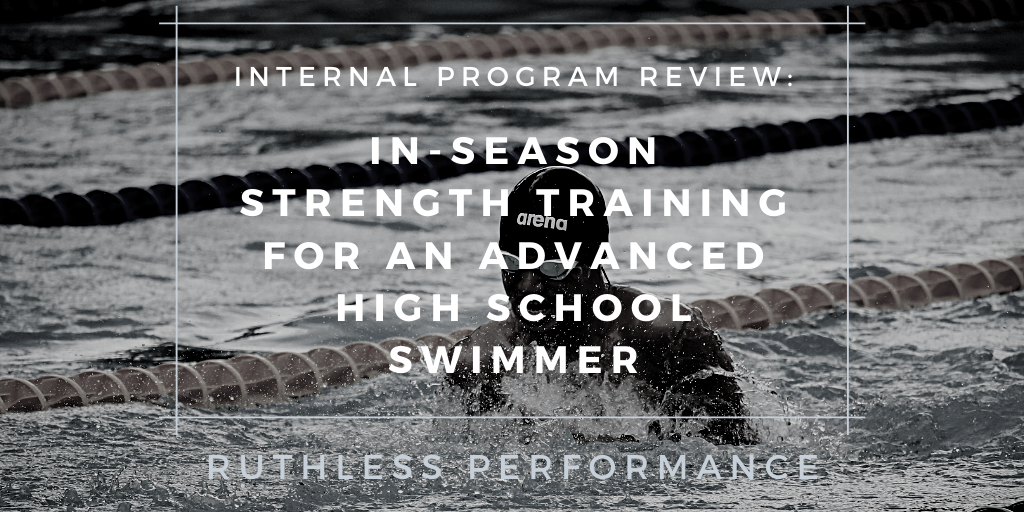Last week, we posted an article explaining that not only are endurance training and strength training acceptable to overlap during the in-season, but that when used concurrently, strength training can actually reduce the chance that an endurance athlete will fall victim to overtraining.
Here is one such example of a program that we developed for one of our more advanced swimmers to perform during the mid-season lull over his holiday break. It’s important to note that he had 4 personal bests the weekend after completion of this program. Again, as I referenced in the overtraining article, in-season strength training also works to keep folks away from bad habits during big holiday breaks.
Additionally, you can safely increase training stress during the winter break (much like you can during the summer) because overall lifestyle stress is much less than it is in the midst of a busy school semester. Since the body treats lifestyle stress as it does physical training stress, there is an inverse relationship between physiological management of these.
In the following internal program review, note that this is an athlete that has worked with us for a good length of time, has been exposed to these exercises previously, and that this is only Day 1 of his training block with us. He has an additional two days per week of training plus additional warm-up, activation drills, and corrective exercises that are not listed herein. This is just a sample for curious minds as to how we program and what a segment of a day-in-the-life of one of our swimmers might look like.
1. Barbell Work Doesn’t Go Away

The Barbell Box Squat is one of the best exercises of all-time. As the swims season extends and kicking sets take on more volume, the Rectus Femoris becomes overactive and tightens. As this muscle tightens in swimmers, it places more and more strain on the hips and low back, manifesting itself as something called anterior pelvic tilt (APT), and as low-back pain.
Beyond discomfort, these tight hip flexors (the Rectus Femoris) and its associated APT change efficiency on the starting block. Because of the antagonistic relationship between the Rectus Femoris and the Glutes, force development coming off of the block can be severely hampered.
The Barbell Box Squat, when coached correctly, helps to reintroduce more glute activation, which is so desperately needed for peak swimming performance. The neutral or negative shin angle (when the knee stays above or behind the ankle when sitting back onto the box) also facilitates more hamstring input. This is similarly valuable for joint health and function because of the role the Rectus Femoris plays at the knee as well. You can read more about the ratio of hamstring to quadriceps strength and the role it plays in performance here. If you’re a triathlete or cyclist, this is doubly true.
As an athlete becomes more competent in the box squat, you can add resistance bands to accommodate the resistance and get more out of the exercise, but bands are in no way a tool for beginners.
2. Healthy Hips with Minimal Soreness

Take all of the nice things I said above about the hamstrings and apply that here as well. Day 1 of this program is a lower body-dominant training day, though the majority of our swimming dryland training workouts are full-body in some capacity.
Here, we’ve added hamstring curls, but not just any hamstring curls. The isometric hamstring curl allows for a greater volume of hamstring work with very little soreness or fatigue. Isometric refers to an exercise done without movement; consider a plank or a wall-sit–these are isometric.
Since the major cause of DOMS (Delayed Onset Muscle Soreness) is the eccentric (lowering) segment of a lift, the isometric aspect of this allows for a greater volume of work to be done without the additional damage incurred during the moving segments of a lift.
The Overhead Med Ball Lunges to Platform starts with a slam ball overhead and both feet planted on a flat surface. As the athlete brings the working leg forward, the foot is met by an elevated surface (about 3 inches above the ground in this case). As long as the support knee has the clearance to hit the flat starting surface, this exercise does wonders for mobility throughout the kinetic chain.
At the hips, this allows for greater range of motion. The shoulders are busy isometrically keeping the ball overhead, allowing for rotator cuff activation. This overhead position also reduces the amount the lats can facilitate any tension on the back, requiring greater trunk activation than would be the case with the ball in a different position.
These two exercises are done back-to-back to ensure the hamstrings and glutes are beating back the default pattern of overreliance on the quads.
3. Conditioning is Done Through Progression of Density

If you’ve read other Internal Programming Review segments you’ve likely seen the 180 Hip Extension, so the addition of this should come as no surprise. Again, maintaining and improving a forceful hip extension at this point in the season should be a primary goal.
This athlete’s final circuit of his Day 1 workout is two exercises which he needs work at. By combining them with a time cap and limited rest, we get the additional benefit of progressing Density. Density is most simply defined as more work within the same period of time. Since the athlete is getting plenty of cardio in the pool, we add these sets sparingly, particularly in-season. The 2-4 minute range is because we’re programing for a mid-distance athlete who will be competing within this range.
We’ve kept the reps low within the sets as a means of controlling for technique as fatigue sets in. 6-8 Reps on these exercises ensure that we’re still stimulating the mid-back in the inverted row and the glutes and hamstrings on the hip extension. You can get a similar training effect by looking for more reps over fewer sets, but more sets with fewer reps ensure technical precision.
AMSAP simply means ‘As Many Sets As Possible’. This is a training strategy that we use for most of our athletes, usually in the midst of their competitive season.
**Editor’s Note: If you have any questions about maximizing swim performance, reach out to us on our contact page.**

